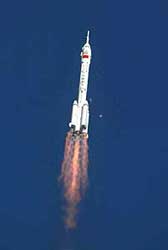 Washington
Times, October 16, 2003 Washington
Times, October 16, 2003
Inside the Ring
By Bill Gertz and Rowan Scarborough
Spy in the sky
China's first manned spacecraft did more than simply
showcase Beijing's efforts for civilian space flight.
The Shenzhou 5, or Divine Vessel 5, spacecraft also
conducted intelligence-gathering work for China's
military.
Included on the top of
the Long March 2F rocket, which boosted Shenzhou into
orbit Tuesday, was a new Chinese military
intelligence-gathering satellite. The satellite was
placed in orbit successfully shortly after the Shenzhou
began its 14-orbit mission. No mention of the satellite
launch was made in the state-run Chinese press.
 Additionally,
defense officials said the single-astronaut spacecraft
carried an infrared camera that conducted photographic
spying. The camera was mounted outside the craft and has
a resolution of 1.6 meters, meaning something as small
as 5 feet wide can be distinguished. Additionally,
defense officials said the single-astronaut spacecraft
carried an infrared camera that conducted photographic
spying. The camera was mounted outside the craft and has
a resolution of 1.6 meters, meaning something as small
as 5 feet wide can be distinguished.
The space spying
highlights China's plans to use space for military
purposes, primarily to develop missiles and sensors, and
to blind or cripple U.S. communications and intelligence
systems in any conflict over Taiwan.
Lt. Col. Mark Stokes,
director of the Taiwan desk at the Pentagon, said in a
speech Sept. 30 that China's space program is closely
linked to the Chinese military.
China's "space assets
will play a major role in any use of force against
Taiwan and in preventing foreign intervention," Col.
Stokes said. It is working to develop networks of
satellites that will be used for spying and
communications for the military, he said.
 China
also has shown "significant indications" of developing
space weapons, such as satellite-killing missiles and
satellites and lasers that can disable U.S. military and
intelligence satellites, he said. China
also has shown "significant indications" of developing
space weapons, such as satellite-killing missiles and
satellites and lasers that can disable U.S. military and
intelligence satellites, he said.
The Long March rocket
booster also benefited from illegal U.S.-technology
transfers in the 1990s, when U.S. satellite companies
helped China fix electrical problems with the boosters.
The booster improvements also benefited Chinese
strategic missiles, which are made by the same Chinese
manufacturers of the Long March rocket.
|